Explore Articles Filed Under: Sacred Plants

Peyote songs are the prayer music and ceremonial heart of the Native American Church. The songs have traditionally been sung, accompanied by the gourd rattle and water drum, in the various languages and musical styles of the indigenous peoples from which the church drew its membership. At the same time, the pan-Indian nature of the church made it a powerful vehicle for the diffusion of musical styles and content. Early studies of peyote songs, dating from the 1940s, found Navajo peyote singers using the Ute musical style, and recognizably the same peyote song among the Tarahumara, Navajo, and Cheyenne.

We have talked about the Fall 1989 issue of the Whole Earth Review. For aficionados of classic psychedelia, however, there is no substitute for the Psychedelic Review, which was sporadically published from 1963 to 1971, and was excerpted for the book The Psychedelic Reader. The entire run of the journal — eleven issues from 1963 to 1971 — is available online, in PDF format, in the Luminist Archives, and on the website of the Multidisciplinary Association for Psychedelic Studies, where individual articles are also accessible.

We have talked before about the Grob, McKenna, Callaway, et al. psychiatric study on the long-term effects of drinking ayahuasca in the ceremonies of the União do Vegetal church. I noted that the study had not clearly disentangled any bias that might have resulted from the fact that the ayahuasca drinkers — but not controls — had been preselected for their orderly churchgoing habits. Here is a study that may shed some light on that question.

The Society for the Anthropology of Consciousness and the Association for Transpersonal Psychology jointly present a conference on Bridging Nature and Human Nature at the Edgefield Resort in Portland, Oregon. The conference is intended to create an “interdisciplinary coalition to help reassess science and culture and the interface between technology and nature” — that is, to call for a more systemic, process-oriented, intimate, and sensual understanding of the universe in which we live.

Jerónimo M. M. is a professor of interactive TV and mobile applications, as well as a consultant on Internet video, online communities, and user experience for such clients as MTV, Tele5, The Movie Channel, and Telefonica. For the past seven years he has been working on a documentary film project entitled The Ayahuasca Conversation.

If you are as old as I am, you remember growing up with the Golden Guide books — sturdy, profusely illustrated, pocket-sized guides to such topics as flowers, planets, spiders, birds, stars, painting, pond life, photography, and rocks and minerals, intended for a young audience. They were perfect for taking along on field trips for identification purposes. The series began in 1949 with Birds and continued — remarkably — until Endangered Animals in 1995. There is, of course, a collector’s website with details about every Golden Guide ever published.

The computer magazine PC World recently published a cluster of exposé articles by staff writer Tom Spring, revealing that a number of more-or-less psychoactive plants and plant extracts — many legal and some not — are easily available online. “At a time when authorities are cracking down on illegal sale of steroids and prescription drugs online,” he writes, “substances such as kratom and Mexican prickly poppy, which pack a psychedelic and narcotic-like punch, are flourishing on the Internet.” One doctor with whom he spoke warned, “With some of these substances it’s like playing Russian routlette with your life.”

I have spoken before about my plant teacher doña María Luisa Tuesta Flores. She was born in September 1940, in the town of Lamas in the province of San Martín, and she died, the victim of sorcery, in July 2006. She had begun her healing career as an oracionista, a prayer healer, and, even after she became an ayahuasquera, her icaros, magic songs, remained inflected with the rhythms and melodies of prayers.

Given the current climate of moral panic and the attendant assault on Salvia divinorum — possession of which is now a felony, at last count, in thirteen states, although it is hard to keep up — I thought we might do some thinking about drugs and the law generally. Let us say that I have been arrested for possession of an illegal hallucinogen. Let us say, too, that I possess that substance, not because it is a sacrament in my church, but because I simply want to experience a hallucinatory mental state. Since I cannot rely on the Religious Freedom Restoration Act, are there any constitutional arguments available to me?

Three important conferences on shamanism were held in 2008, two of which were not easy to get to from the United States — the World Psychedelic Forum in Basel, Switzerland, March 21–24, and the Fourth Annual Amazonian Shamanism Conference in Iquitos, Peru, July 19–27. A third conference — the 25th International Conference on Shamanism and Alternative Modes of Healing — was held closer to home, in San Rafael, California, August 30–September 1. If you missed these conferences, there are still ways to access at least some of the presentations.

Discussing the article:
Hallucinogens in Africa